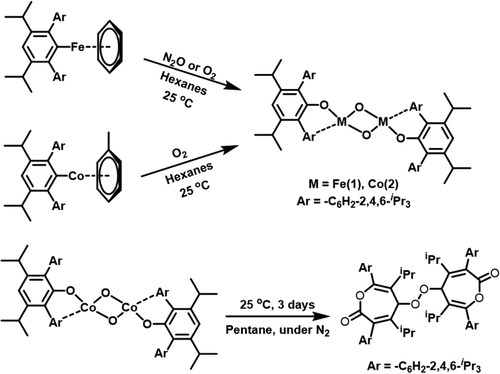当前位置:
X-MOL 学术
›
Inorg. Chem.
›
论文详情
Our official English website, www.x-mol.net, welcomes your feedback! (Note: you will need to create a separate account there.)
Quasi-Three-Coordinate Iron and Cobalt Terphenoxide Complexes {AriPr8OM(μ-O)}2 (AriPr8 = C6H-2,6-(C6H2-2,4,6-iPr3)2-3,5-iPr2; M = Fe or Co) with M(III)2(μ-O)2 Core Structures and the Peroxide Dimer of 2-Oxepinoxy Relevant to Benzene Oxidation
Inorganic Chemistry ( IF 4.3 ) Pub Date : 2015-09-02 00:00:00 , DOI: 10.1021/acs.inorgchem.5b00930 Pei Zhao 1 , Hao Lei 1 , Chengbao Ni 1 , Jing-Dong Guo 2 , Saeed Kamali 1 , James C. Fettinger 1 , Fernande Grandjean 3 , Gary J. Long 3 , Shigeru Nagase 2 , Philip P. Power 1
Inorganic Chemistry ( IF 4.3 ) Pub Date : 2015-09-02 00:00:00 , DOI: 10.1021/acs.inorgchem.5b00930 Pei Zhao 1 , Hao Lei 1 , Chengbao Ni 1 , Jing-Dong Guo 2 , Saeed Kamali 1 , James C. Fettinger 1 , Fernande Grandjean 3 , Gary J. Long 3 , Shigeru Nagase 2 , Philip P. Power 1
Affiliation

|
The bis(μ-oxo) dimeric complexes {AriPr8OM(μ-O)}2 (AriPr8 = C6H-2,6-(C6H2-2,4,6-iPr3)2-3,5-iPr2; M = Fe (1), Co (2)) were prepared by oxidation of the M(I) half-sandwich complexes {AriPr8M(η6-arene)} (arene = benzene or toluene). Iron species 1 was prepared by reacting {AriPr8Fe(η6-benzene)} with N2O or O2, and cobalt species 2 was prepared by reacting {AriPr8Co(η6-toluene)} with O2. Both 1 and 2 were characterized by X-ray crystallography, UV–vis spectroscopy, magnetic measurements, and, in the case of 1, Mössbauer spectroscopy. The solid-state structures of both compounds reveal unique M2(μ-O)2 (M = Fe (1), Co(2)) cores with formally three-coordinate metal ions. The Fe···Fe separation in 1 bears a resemblance to that in the Fe2(μ-O)2 diamond core proposed for the methane monooxygenase intermediate Q. The structural differences between 1 and 2 are reflected in rather differing magnetic behavior. Compound 2 is thermally unstable, and its decomposition at room temperature resulted in the oxidation of the AriPr8 ligand via oxygen insertion and addition to the central aryl ring of the terphenyl ligand to produce the 5,5′-peroxy-bis[4,6-iPr2-3,7-bis(2,4,6-iPr3-phenyl)oxepin-2(5H)-one] (3). The structure of the oxidized terphenyl species is closely related to that of a key intermediate proposed for the oxidation of benzene.
中文翻译:

准三坐标铁和钴对苯二氧化物配合物{Ar i Pr 8 OM(μ-O)} 2(Ar i Pr 8 = C 6 H-2,6-(C 6 H 2 -2,4,6- i Pr 3)2 -3,5- i Pr 2; M = Fe或Co),具有M(III)2(μ-O)2核心结构和与苯氧化有关的2-Oxepinoxy过氧化物二聚体
双(μ-氧代)二聚体复合物{Ar i Pr 8 OM(μ-O)} 2(Ar i Pr 8 = C 6 H-2,6-(C 6 H 2 -2,4,6- i Pr 3)2 -3,5-我镨2 ; M = Fe(上1),CO(2))通过氧化制得的M(I)半夹心络合物{氩我镨8 M(η 6 -arene) }(芳烃=苯或甲苯)。铁物质1的制备是通过反应{氩我镨8的Fe(η 6苯)}用N 2 O或O 2,和钴物质2是由反应{氩制备我镨8(η钴6 -甲苯)}为O 2。既1和2通过X射线晶体学,UV-vis光谱,磁测量进行表征,并且,在的情况下1,穆斯堡尔谱。两种化合物的固态结构均显示具有独特的三配位金属离子的M 2(μ-O)2(M = Fe(1),Co(2))核。在铁的Fe ...分离1承载在铁一相似于提出了用于甲烷单加氧酶中间体Q的2(μ-O)2金刚石核。1和2之间的结构差异反映在相当不同的磁性能中。化合物2是热不稳定的,其在室温下的分解导致Ar i Pr 8配体通过氧的插入而氧化,并加成至三联苯配体的中心芳基环上,从而生成5,5'-过氧-双[4] ,6- i Pr 2 -3,7-bis(2,4,6- i Pr 3-苯基)oxepin- 2(5 H)-one](3)。氧化的三联苯物种的结构与提议用于苯氧化的关键中间体的结构密切相关。
更新日期:2015-09-02
中文翻译:

准三坐标铁和钴对苯二氧化物配合物{Ar i Pr 8 OM(μ-O)} 2(Ar i Pr 8 = C 6 H-2,6-(C 6 H 2 -2,4,6- i Pr 3)2 -3,5- i Pr 2; M = Fe或Co),具有M(III)2(μ-O)2核心结构和与苯氧化有关的2-Oxepinoxy过氧化物二聚体
双(μ-氧代)二聚体复合物{Ar i Pr 8 OM(μ-O)} 2(Ar i Pr 8 = C 6 H-2,6-(C 6 H 2 -2,4,6- i Pr 3)2 -3,5-我镨2 ; M = Fe(上1),CO(2))通过氧化制得的M(I)半夹心络合物{氩我镨8 M(η 6 -arene) }(芳烃=苯或甲苯)。铁物质1的制备是通过反应{氩我镨8的Fe(η 6苯)}用N 2 O或O 2,和钴物质2是由反应{氩制备我镨8(η钴6 -甲苯)}为O 2。既1和2通过X射线晶体学,UV-vis光谱,磁测量进行表征,并且,在的情况下1,穆斯堡尔谱。两种化合物的固态结构均显示具有独特的三配位金属离子的M 2(μ-O)2(M = Fe(1),Co(2))核。在铁的Fe ...分离1承载在铁一相似于提出了用于甲烷单加氧酶中间体Q的2(μ-O)2金刚石核。1和2之间的结构差异反映在相当不同的磁性能中。化合物2是热不稳定的,其在室温下的分解导致Ar i Pr 8配体通过氧的插入而氧化,并加成至三联苯配体的中心芳基环上,从而生成5,5'-过氧-双[4] ,6- i Pr 2 -3,7-bis(2,4,6- i Pr 3-苯基)oxepin- 2(5 H)-one](3)。氧化的三联苯物种的结构与提议用于苯氧化的关键中间体的结构密切相关。













































 京公网安备 11010802027423号
京公网安备 11010802027423号